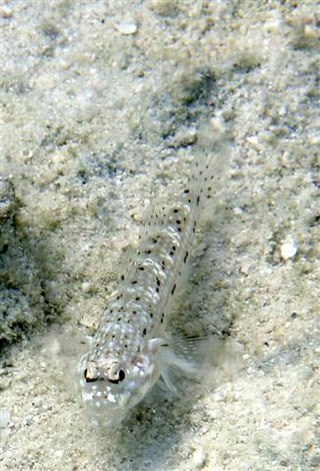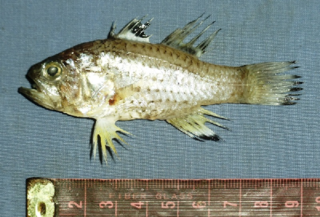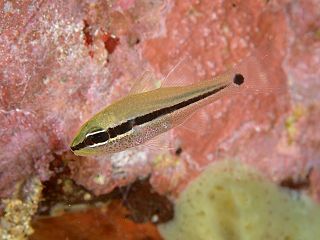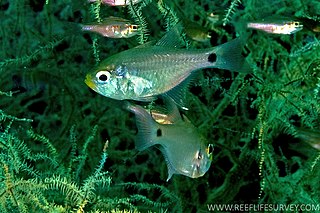
Gobiodon is a genus of gobies also known as coral gobies or "clown gobies". Generally, coral gobies, unlike the rest of the family Gobiidae, are not burrowers, but instead prefer to inhabit the branches of certain Acropora or similar hard corals.

Apogon is a large genus of fish in the family Apogonidae, the cardinalfishes. They are among the most common fish on coral reefs. Over 200 species have been classified in genus Apogon as members of several subgenera. Some of these subgenera, such as Ostorhinchus, have been elevated to genus status, leaving just over 50 species in the genus.

Fusigobius is a genus of coral reef inhabiting gobies found throughout the Indian and western Pacific Oceans.

Acentrogobius is a genus of gobies native to marine, fresh and brackish waters of the coasts of the Indian Ocean and the western Pacific Ocean.

Cirripectes is a large genus of combtooth blennies found throughout the Pacific and Indian oceans. Cirripectes biconvexus, an otolith based fossil species from the Burdigalian (Miocene) of southwestern India is probably the earliest record of this genus.

Apogonichthyoides is a genus of fish in the family Apogonidae, the cardinalfishes. They are native to the Indian Ocean and the western Pacific Ocean.

Cercamia is a genus of fishes in the family Apogonidae, the cardinalfishes. They are native to the Pacific and Indian Oceans.

Cheilodipterus is a genus of fishes in the family Apogonidae, the cardinalfishes. They are native to the Indian Ocean and the western Pacific Ocean.

Gymnapogon is a genus of fish in the family Apogonidae. They are native to the Indo-West Pacific and central Pacific Oceans, where they occur in reefs and nearby habitat types. These species are usually no more than 5 centimeters long and have semitransparent bodies without scales. The genus name is a compound noun formed by combining the Greek gymnos meaning "naked", referring to the lack of scales in the type species, Gymnapogon japonicus, and Apogon, the type genus of the Apogonidae. One species, the B-spot cardinalfish, is notable for its larvae being rather large, conspicuous and fast-swimming.

Jaydia is a genus of fishes in the family Apogonidae native to the western Pacific Ocean.

Ostorhinchus is a genus of ray-finned fish in the family Apogonidae native to the Indian and Pacific Oceans.

Pristiapogon is a genus of cardinalfishes native to the Indian and Pacific Oceans.
Pseudamia is a genus of cardinalfishes native to the Indian and Pacific oceans.
Pseudamiops is a genus of cardinalfishes native to the Pacific and Indian oceans.
Ancistrogobius is a genus of gobies native to the western Pacific Ocean. The first fossil record of this genus is Ancistrogobius indicus from the Burdigalian of southwestern India.

Drombus is a genus of gobies native to fresh, brackish and marine waters of the Indian Ocean and the western Pacific Ocean.

Archamia bleekeri, also known as Gon's cardinalfish, is a species of fish in the family Apogonidae, the cardinalfishes. It is native to the coastal waters of the Indian Ocean and the western Pacific Ocean from Africa to Indonesia and from Taiwan to Queensland, Australia. This species occurs in mangrove forests and reefs, and is an inhabitant of shipwrecks, preferring silty areas with muddy or sandy substrates. This species grows to a total length of 10 cm (3.9 in). This species is the only member of the genus Archamia. The other species were moved to the new genus Taeniamia in 2013.

Taeniamia is a genus of cardinalfishes native to the Indian Ocean and the western Pacific Ocean.

Fibramia is a genus of fishes in the family Apogonidae from the Indian Ocean. The first fossil record of this genus is Fibramia keralensis from the Burdigalian (Miocene) of southwestern India.
Siphamia tubifer, also known as the sea urchin cardinalfish, is a small (~7 cm) coral reef fish in the family Apogonidae. Its geographic range extends from East Africa to the French Polynesian Islands.
















